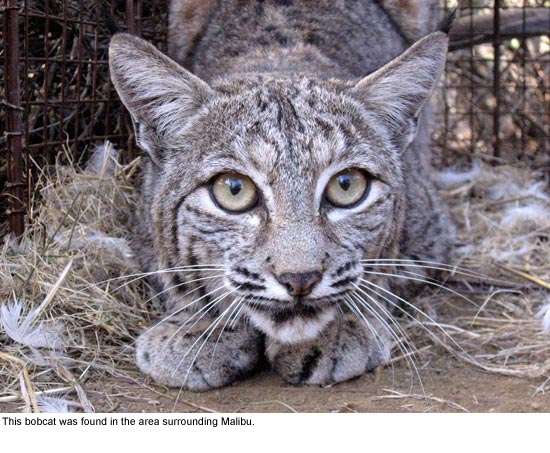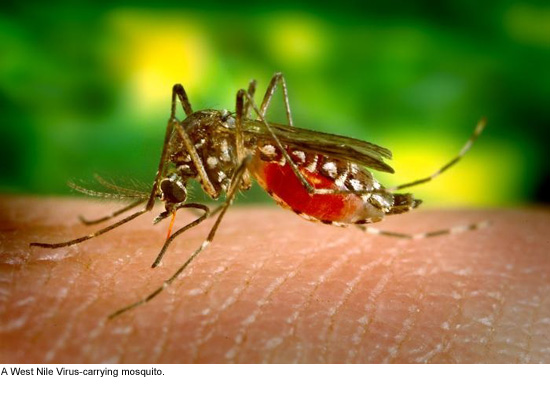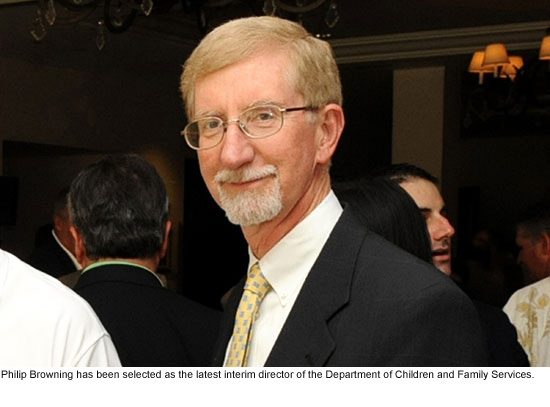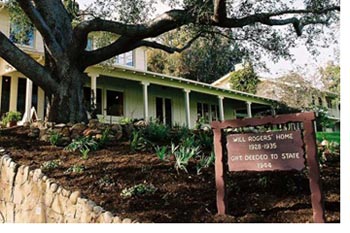Could curiosity save the bobcat?
August 11, 2011

Many people call the picturesque Santa Monica Mountains and Hollywood Hills home, but not all residents benefit from human development. Learn about one who doesn’t–the bobcat–from “urban carnivore” expert Laurel Klein at Temescal Gateway Park.
Each bobcat requires a fairly large “home range” to hunt and reproduce, according to Klein’s website. When human development encroaches, a cat’s habitat is altered, and it can find itself in the midst of a challenging urban environment.
“It’s pretty easy in Topanga,” says Klein, “but harder in places like Beverly Hills or Bel Air. There is a lot of habitat fragmentation. They have to cross busy roads like Mulholland or Beverly Glen.”
Bobcats, which can grow to 40 pounds or more, rarely threaten humans and will generally flee if approached, according to Los Angeles Animal Services. The main threat they pose is to small animals, or if they are sick, cornered, or protecting their young. Even then, local officials have not encountered many issues.
“Our experience with bobcats is that they are never a problem, unless you own a chicken farm or something,” said Ray Smith, deputy director of the L.A. County Weed Hazard and Pest Management Bureau. “Coyotes are much more of a risk around here.”
If you want to know more, just ask Klein, who has been researching bobcats and other carnivores of L.A. County since 2006. She is currently pursuing a Ph.D. of Ecology and Evolutionary Biology through a joint program from UCLA and the National Park Service. On Tuesday, she will present the results of her studies, lecture on protecting the cats, and show off some of her best pictures.
Her talk, “Get to Know the Locals: Bobcats,” is the latest installment of “Culture in the Canyon at the Chautauqua,” a free program sponsored by the Santa Monica Mountains Conservancy and presented by the Mountains Recreation & Conservation Authority. The series takes place the third Thursday of each month.
The bobcat presentation is at 7:30 p.m. this Tuesday, August 16. It takes place in Woodland Hall at Temescal Gateway Park, just off the PCH in Pacific Palisades. Parking is free for the event.
If you can’t make it there but want to help local bobcats anyway, you can always donate to conservation efforts, or just follow this tip:
“Avoid using rat poisons,” says Klein. “There is a lot of rat poison used around homes. We know that bobcats and many other species have died from exposure to it.”
Posted 8/11/11
Here’s the lowdown on West Nile scare
August 10, 2011
 Mosquitoes aren’t high on the list of seasonal worries in Los Angeles County. But with two new cases of West Nile virus confirmed here in recent days, the fear factor is rising fast.
Mosquitoes aren’t high on the list of seasonal worries in Los Angeles County. But with two new cases of West Nile virus confirmed here in recent days, the fear factor is rising fast.
“There shouldn’t be cause for panic,” says Dr. Jonathan E. Fielding, director of the county Department of Public Health. “But we do want to remind people to take appropriate precautions.”
For example, Fielding says, discourage mosquitoes from breeding near your home by getting rid of pools of stagnant water, and use a repellent containing DEET when you’re outdoors in mosquito-prone areas, especially around dawn or dusk.
The two victims reported this week in Los Angeles County were both middle-aged men, one in the San Gabriel Valley and the other in the San Fernando Valley. Both had pre-existing conditions,and both are recovering, Fielding says.
Though officials aren’t sure what has caused the spike in human cases, the good news is, most mosquitoes aren’t carriers of the virus, which is spread to humans from infected birds. And of the few people who do become exposed, says Fielding, only about one in 150 ends up in the hospital. The vast majority either suffer only minor flu-like symptoms or don’t get sick.
Still, eight human cases have been reported so far this year in five California counties and the virus can cause encephalitis and death in that rare minority. So here are some Department of Public Health recommendations:
- Avoid mosquito-infested areas at dawn and dusk.
- Wear long-sleeved shirts and long pants whenever you are outdoors.
- Repellants containing DEET, picaridin, or oil of eucalyptus, when used as labeled, are effective defenses against mosquitoes.
- Check your window screens for holes.
- Do not allow water to collect and stagnate in old tires, flowerpots, swimming pools, birdbaths, pet bowls, or other containers. These are prime breeding grounds for mosquitoes.
- Clean and chlorinate swimming pools; drain water from pool covers.
- Stock garden ponds with goldfish or other mosquito- eating fish. These eat mosquito eggs and larvae.
- Empty and wash birdbaths and wading pools weekly.
- If a recently dead bird (less than 24 hours) is found, call (877) 747-2243 for instructions on handling.
- Report “green pools” or stagnant swimming pools in Los Angeles County by calling the Public Health Environmental Health Bureau at (626) 430-5200.
- If you need more information on West Nile, call (800) 975-4448.
- For even more information, including statewide updates and local numbers to call if you have questions about mosquitoes, click here or here. For more on the disease itself, click here. And for advice from the Centers for Disease Control and Prevention, click here.
Posted 8/10/11
A star is worn (but help’s on the way)
August 10, 2011

Groucho Marx is cracking up. Burt Lancaster looks ready for some rehab. And as for Kermit the Frog—well, let’s just say his current situation is something you wouldn’t wish on a reptile.
We’re talking, of course, about stars on the Hollywood Walk of Fame, where years of damage and deterioration have taken a heavy toll. Now, some of the Walk’s most visible stars are ready for their touch-up.
Metro’s Board of Directors recently voted to spend $1.5 million to fix up the stars and their surroundings outside the Hollywood/Highland Red Line station as part of a cost-sharing agreement with the Hollywood Historic Trust, which will carry out the work. Other funding for the $4.1 million project is coming from the City of Los Angeles’ Community Redevelopment Agency, the Hollywood Chamber of Commerce, the Hollywood Historic Trust and private donors.
“The Walk of Fame…has been showing its age for some time,” according to a report to Metro’s Executive Management and Audit Committee. “Over the past 50 years, the condition of the sidewalks has become unsightly and potentially dangerous.”
A major focus of the work will be the north side of Hollywood Boulevard between Highland Avenue and Orange Drive.
The fix-up operation, expected to begin this fall, comes after research into how best to resolve long-standing problems along the famed pink-and-black terrazzo Walk. The review included assigning a letter grade to the condition of each of the Walk’s nearly 2,400 stars—from A to F. The Los Angeles City Council earlier this year adopted new specifications on how the work should be conducted.
Among the 180 star panels likely to be restored or replaced are those honoring Groucho, Burt Lancaster and Kermit (all of which were graded “C”) along with stars in even worse shape (“D” or “F”) paying homage to Peter Frampton, Jackie Chan, Tony Curtis and Harriet Nelson.
“The overall condition of the Walk along this portion is in poor condition. There are multiple areas where the terrazzo layer is completely missing,” the Metro report said.
The work will focus not just on replacing the stars themselves but also on shoring up or replacing damaged sidewalks, curb ramps and driveways.
People walking to and from the Hollywood and Highland Red Line station should expect some pedestrian detours once the work gets underway; it’s expected to take from three to five months.
More than 10 million people a year visit the Walk, which runs along Hollywood Boulevard from Gower Street to La Brea Avenue and on Vine Street from Yucca Street to Sunset Boulevard. Their numbers are likely to increase now that a new Cirque du Soleil production has taken up residence at the Kodak Theater, the Metro report said.
Previous repairs on the Walk of Fame near Hollywood and Vine were funded by the developer of the W Hotel Hollywood, which opened earlier this year. And individual star panels and areas of the Walk have been repaired one by one over the years, said Jeffrey C. Briggs, a Hollywood Historic Trust board member who also serves as the organization’s legal counsel.
But the upcoming renovation will be the first large-scale effort since the new city guidelines were enacted.
“Metro’s contribution is extremely important and is critical to the overall long-term maintenance of the Walk of Fame, which is the No. 1 tourist destination in Southern California,” Briggs said.
Posted 8-9-11
The Browning of DCFS
August 10, 2011
 Philip Browning’s wife was, to put it kindly, skeptical when her husband told her that he’d been tapped to temporarily take control of Los Angeles County’s deeply troubled Department of Children and Family Services. “Why,” she asked, “would you want to take on a situation like that?”
Philip Browning’s wife was, to put it kindly, skeptical when her husband told her that he’d been tapped to temporarily take control of Los Angeles County’s deeply troubled Department of Children and Family Services. “Why,” she asked, “would you want to take on a situation like that?”
After all, Browning had emerged as one of the county’s most innovative and effective executives while running the huge Department of Public Social Services, which provides safety-net services for more than 2.6 million people on the economic margins of society.
Browning’s answer to his wife, who used to be a child protective services worker, was simple and direct: he was jumping into the DCFS pressure cooker because the Board of Supervisors asked him to do so.
“I was in the military for a long time and was accustomed to being asked to do things not entirely of my own choosing,” says Browning with a hint of his Southern gentility. “I think I have a sense of obligation.”
With the board’s official and unanimous vote for Browning this week, he becomes DCFS’ third interim director in the past nine months, following the dismissal of permanent chief Trish Ploehn amid an uproar over a number of high-profile child deaths and questions about the department’s forthrightness.
Browning was selected by board members who’d grown so dissatisfied that they retook control of the department’s management several months ago from the chief executive office, which had been given that responsibility as part of a sweeping remake of county government in 2007.
Although Browning is an interim director, the board has made it clear that they do not want just a seat-warmer while a search is underway for a permanent boss. He is empowered to take the actions necessary to improve the agency’s performance, as he has done at DPSS, making it among the nation’s leaders in serving its clients.
Whether at DPSS or DCFS, Browning says he offers a consistent approach. “The goal is to hire qualified people, get them trained and hold them accountable.” He says he knows that, for some managers, that final piece—accountability—can be uncomfortable.
“It’s tough to take the difficult disciplinary actions. We let people stay in positions where we know they should be moved,” says Browning, recalling times that he’s recommended the dismissals of longtime DPSS employees for violating client confidentiality or committing other serious transgressions.
That said, Browning is known as a team builder—more inclined to motivate than criticize. He also is legendary for his reliance on statistics to gauge an operation’s effectiveness. “Without good data,” he says, “you can’t change a program.”
At DPSS, he says, “we measure everything that is possible to be measured.” Those numbers are then analyzed monthly in a formal setting by managers.
“When I first came to DPSS, it was a very scary process,” Browning says of those sessions. “People would throw up before the meeting. The prior administration was more into criticism. It put too much stress on our employees. I just changed the focus. I told them we are all in this together. Let’s share our secrets of success. Let’s don’t try to be so competitive.”
Late Tuesday, after the board’s vote, Browning sent a memo to DCFS employees. He knows that some of them undoubtedly will be questioning the wisdom of selecting someone not currently immersed in Los Angeles’ child welfare system.
So he wrote of his masters of social work degree and the many years he spent in human services in Alabama and later in Washington, D.C. He recounted his 2001 hiring to turnaround a Los Angeles County District Attorney operation that had been widely criticized for failing to aggressively obtain child support money from so-called deadbeat dads. As the first director of child support services, his office increased collections 36% to $500 million and, he wrote, “moved the agency from a law enforcement system to a human services culture with a priority on customer service.”
Then, after talking about his belief in data, accountability and wellness programs (“I ran my five miles today,” he noted), Browning closed by saying that “the work performed by DCFS is some of the most challenging in America and…will certainly be a challenge to me.”
“I need your help and support.”
Posted 8/10/11
A youth chorus to sing about
August 10, 2011

If you’re young and musically inclined, this just might be your big break. Auditions for the fall season of the San Fernando Valley Youth Chorus are around the corner.
The Youth Chorus gives kids in grades 3 through 12 the opportunity to receive top-notch singing instruction at low cost ($150 for a whole semester). It rehearses Sunday afternoons from 2:30 p.m. to 6 p.m., and performs live at a variety of venues. Last year, chorus members sang at the Dorothy Chandler Pavilion, the Heritage Festival in San Diego and the Arts in Education Showcase at the Madrid Theatre.
Founded in 1992, the non-profit San Fernando Valley Youth Chorus uses the gift of song to help young people gain self-esteem, self-discipline and creativity. Its repertoire ranges from Renaissance-era classics to Broadway hits, and there is an emphasis on community engagement with performance. All ethnicities, cultures, religions and economic backgrounds are welcome.
Auditions are August 21 and 28 from 3 p.m. to 5 p.m. at Canoga Park Methodist Church, 22700 Sherman Way. Call (818) 212-9356 for an appointment, or email [email protected].
Posted 8/10/11
Never met a movie he didn’t like
August 10, 2011
With the warmth of summer days stretching into evening, it might be just the time for an outdoor movie. This Friday, August 12, celebrate a little Hollywood history on the lawn at the Will Rogers Ranch in Pacific Palisades.
The 6th annual “Movies in Will’s Backyard,” features an outdoor screening of the classic 1932 film Too Busy to Work (starring Will Rogers, of course). In the movie, Rogers plays a vagabond who travels to California to confront a man who stole his wife while he was at war. Eventually he lands a job working for the man, and is faced with a choice of forgiveness or revenge.
Free popcorn will be available during the film, and for those who want to buy more substantial fare, the gourmet vendors Grilled Cheese Truck and Flat Iron are stopping by, too. The ranch house and visitor’s center will be open for tours before show time.
 The film starts at 7:30 p.m. Friday at 1501 Will Rogers State Park Road. Parking is available at the reduced rate of $6 after 6 p.m. (the normal rate is $12 per vehicle). And it’s strictly BYOB (as in, Bring Your Own Blanket).
The film starts at 7:30 p.m. Friday at 1501 Will Rogers State Park Road. Parking is available at the reduced rate of $6 after 6 p.m. (the normal rate is $12 per vehicle). And it’s strictly BYOB (as in, Bring Your Own Blanket).
Posted 8/10/11
This’ll float your boat
August 10, 2011
Tired of buying plastic toys that quickly land in junk drawers and trash cans? Your kids can find out how to make their own from natural materials at UCLA’s Fowler Museum.
In “Kids in the Courtyard: Float Your Boat,” children learn to make dolls and boats from tule reeds, as well as paper boats (ti’ats) in the style of the native Tongva (later known as Gabrielinos.) The program accompanies the exhibit Launching a Dream: Reviving Tongva Maritime Traditions, which documents the rebirth of early native coastal communities in Southern California with a series of photographs.
The Fowler Museum explores and celebrates the diverse peoples and cultures of our world, both past and present. The toy-making workshop is the museum’s latest installment in a series of interactive, educational programs for children.
The event runs from 2 p.m. to 5 p.m. on Sunday, August 14. Admission is free to the workshop and the museum, which is at the north end of UCLA’s main campus. Check its website for directions, hours and instructions on parking. Happy sailing!
Posted 8/10/11
Foster teens on a new course at UCLA
August 7, 2011
A really long goodbye to Wilshire ramps
August 4, 2011
Carmageddon, as the whole world knows by now, came to a happy, early close. Now it’s time to start thinking about the 405 Project’s next big closure: the Wilshire Boulevard ramps in Westwood.
Sometime this fall, two Wilshire on- and off-ramps to the 405 Freeway will be closed for 90 days. That work will be followed by a series of closures of the other Wilshire ramps, each expected to last from 14 to 90 days. (There are eight ramps in all, and they will be worked on two at a time.)
The end result should be sweet: modern, swooping flyover ramps that will make it easier to navigate the notoriously jammed intersection.
But getting to that point may be considerably less so, in the view of residents of neighborhoods around the construction.
“That’s going to be the next shoe to drop,” said Steve Resnick, president of the Westwood Homeowners Association. “The 405 closure, as it turned out, was just the opposite of what was expected. It was terrific. The feeling is that this could be much worse.”
The tentative schedule for the project says the ramps are set to close in October, but project officials say the work is actually likely to begin in November. The ramps that will be closing first are the westbound Wilshire on-ramp to the northbound 405 and the northbound 405 off-ramp to westbound Wilshire.
It’s all part of a massive, $1.034 billion project, set to finish in 2013, that will add a 10-mile northbound carpool lane to the 405 along with other improvements such as the flyover ramps at Wilshire.
There are also concerns at UCLA. The closures will have a “significant impact on traffic congestion and commute patterns in and around Westwood,” Renée A. Fortier, Executive Director, UCLA Events & Transportation, said in a statement. She said the university is working with project officials to minimize “cut-through” traffic on the campus, particularly around Ronald Reagan UCLA Medical Center. It also plans to take steps to publicize the closures in advance and to encourage students and employees who live north of the Sepulveda Pass to to join existing rideshare programs.
Adding to the trepidation about the upcoming ramp closures is that utility relocation work will be taking place at the same time on Sepulveda Boulevard—the designated detour route.
“It is our goal to keep Sepulveda open with 2 lanes in each direction as much as possible,” said Kasey Shuda, acting community relations manager for the project.
Even so, people in the Westwood Hills neighborhood are bracing for congestion, said Debbie Nussbaum, who represents the area on the project’s community advisory committee.
“In our little neighborhood, we’re very concerned. When things get backed up, people start looking for shortcuts—even when there aren’t any,” she said. “The Mulholland Bridge went pretty smoothly, but at most that was going to be 53 hours. This is 90 days, 24/7. People can’t stay home for that length of time.”
Shuda said the project will bring in traffic control officers to help keep things moving along the detour route as the ramp closure gets underway. Officials also will be using changeable message signs to get the word out to motorists approaching the area and will keep a close eye on signal timing on affected streets. And they’re taking suggestions from the community. (The next meeting is scheduled for Aug. 18.)
For her part, Nussbaum would love to see a special park-and-ride lot designated during the closure, with free rides offered on buses headed into and out of the area. And she’s hoping that some of the public-spirited mindset that applied during Carmageddon will kick in among those who need to travel to Westwood each day.
“Even if they carpooled a couple of days a week, that would make a difference,” she said. “Unless people do something voluntarily, it’s going to be pretty gridlocked over here.”
Posted 8/4/11













 Check for the latest closure information
Check for the latest closure information








